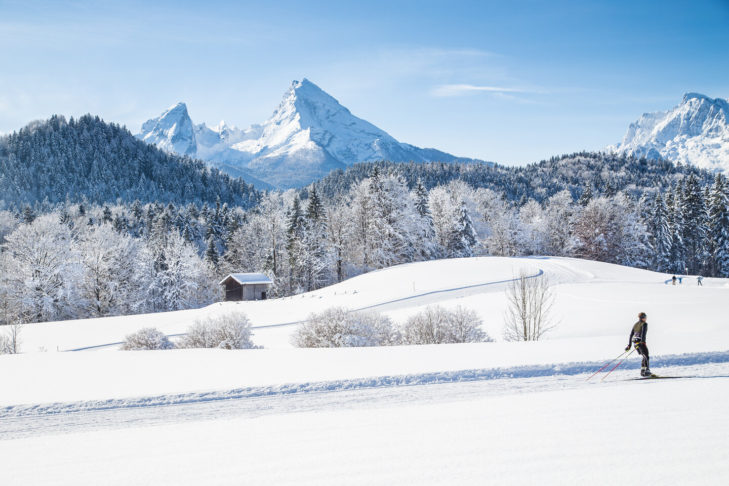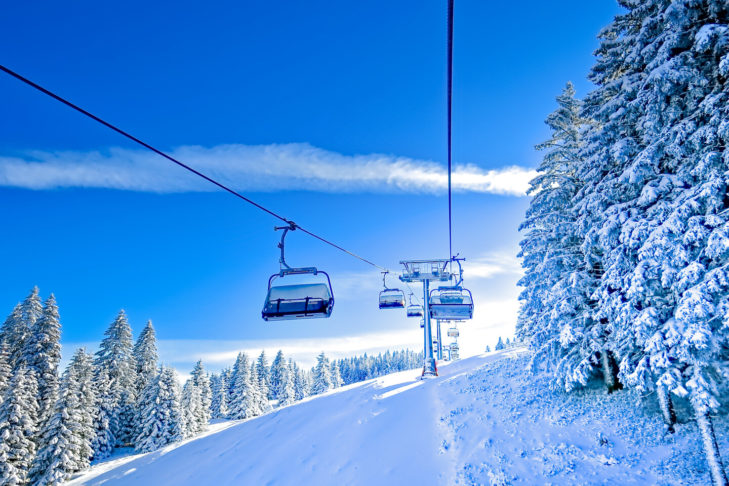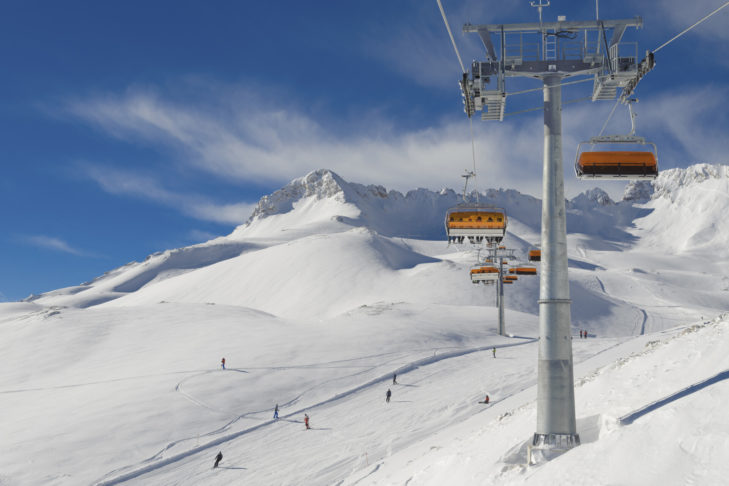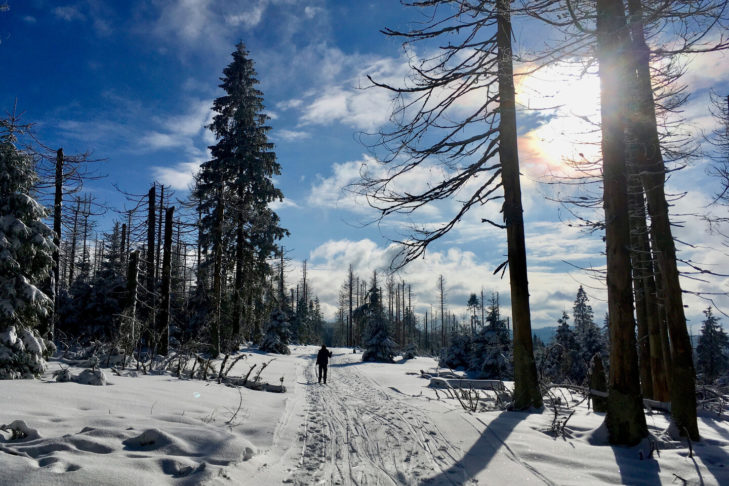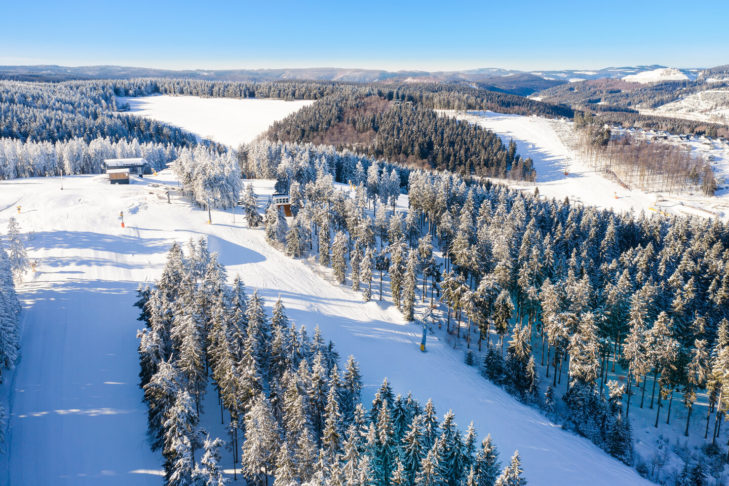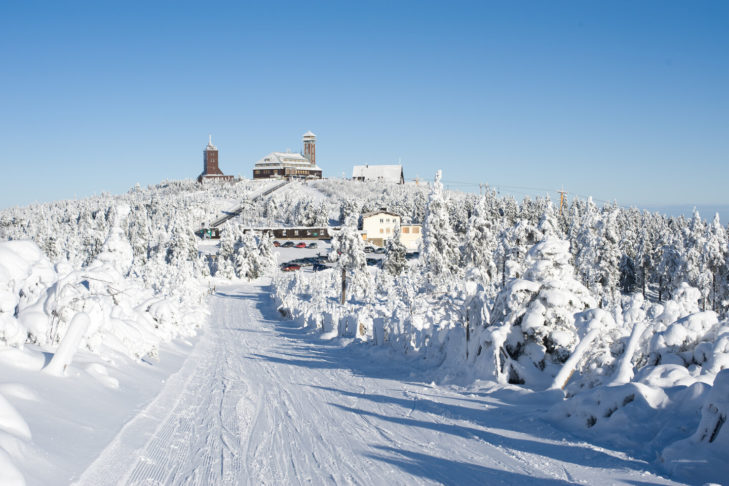For many winter sports enthusiasts, Austria is the first destination for a fulfilling ski holiday. However, the central German uplands and the regions on the edge of the Alps also have a lot to offer families. So why not consider the beautiful pistes of the country home to the Zugspitze or the fairytale-like Black Forest? SnowTrex answers the question: Where can you ski in Germany?
Skiing & cross-country skiing in Germany in around 200 ski resorts
If you look at the map, there are great landscapes almost everywhere in central and southern Germany, which are home to both smaller and larger ski resorts. In total, there are around 200 ski resorts on German soil. If you include every local mountain in even the smallest village, there are well over 200. The beauty of the winter sports regions in Germany is their versatility. If the altitude and area capacity do not allow for a large ski area, the alternative sports programme is all the greater. In many places, the terrain is wide and relatively flat, so that cross-country skiing centres, for example, have developed with a great network of trails. Nordic sports are still a big trend, especially in federal states such as Thuringia and Saxony.
Skiing in the south of Germany
The further south, the more athletically challenging the pistes, right? After all, the Bavarian Alps are over 2,500 metres high. But Bavaria also has great ski regions for beginners and experts alike, such as the Berchtesgadener Land ski region with the majestic Watzmann (2,713 m elevation). Five resorts cater to winter sports enthusiasts of all levels, especially families with children.
The Großer Arber ski area (1,456 metres) in the Bavarian Forest is also a popular destination for families and beginners. Not only is this the highest peak in the region, but with 11.5 kilometres of pistes it is also the largest ski area in the Bavarian Forest. A big plus is the beginners’ area with four magic carpets and the aptly named ArBär-Kinderland. It makes sense that the local mascot in the form of a bear helps children to learn.
When it comes to family pistes, the Kniebis mountain in the Black Forest should not be forgotten. This is notorious for its snowy forests near Freudenstadt (732 m). The Freudenstadt-Kniebis ski area is a particularly popular destination for families and offers two T-bar lifts with 1 km of pistes on the Kniebis itself as well as several other lifts in the surrounding area.
In addition to family pistes, there are of course also more varied and more difficult runs in the south of Germany. Not only pleasure skiers, but also piste cracks and off-road skiers are well catered for here in numerous ski resorts. The Feldberg lift network on the summit of the same name (1,493 m), for example, offers runs with a high level of difficulty. It is the largest interconnected ski area in the Black Forest with 38 lifts and 63 kilometres of pistes. There’s a total of 11 kilometres of black slopes, including the very challenging FIS World Cup downhill run.
The Brauneck-Wegscheid ski area in Lenggries-Wegscheid with 32 kilometres of slopes and the Oberstdorf & Kleinwalsertal ski region, where a total of around 120 kilometres of slopes run from Fellhorn and Kanzelwand – partly on the Austrian side – are also worth mentioning for sporty skiers. The pistes in Bavaria’s southernmost municipality prove that you can also enjoy excellent skiing in the Oberallgäu. Night skiing and a snow park for freestylers are also on offer. The Four Hills Tournament in Oberstdorf also attracts many guests to the region every year and is definitely worth a visit.
Last but not least, when it comes to skiing in the south of Germany, the top areas in Garmisch-Partenkirchen and the ski area on the Zugspitze, Germany’s only glacier area, which reaches up to 2,720 metres, should also be mentioned. The upper section, the Zugspitzplatt, combines rather easy and moderately difficult pistes, whereas the somewhat lower, larger Garmisch-Classic ski area has even more steep runs to offer. 10 kilometres of deep black pistes wind their way down from the Kreuzjoch, Kreuzeck and Hausberg. The most famous is certainly the 3 km long Kandahar World Cup run.
Skiing in the centre of Germany
Many small, simple, but no less beautiful ski resorts can be found in Germany’s larger low mountain ranges. The highest mountain in the Harz Mountains and one of the best-known holiday destinations in Saxony-Anhalt is the Brocken (1,141 m). It is a holiday destination with an absolute winter wonderland factor: in the Braunlage Wurmberg ski area (970 m), snow lovers have around 12 km of slopes at their disposal. The different levels of difficulty promise variety and new challenges for every level. If that’s not enough, there is also a fun park, a toboggan run and a snow tubing piste.
There are also other small ski areas not far from the Brocken, such as the Bocksberg ski area (726 m). In a quiet location, it offers five idyllic slopes and a total of around 4 kilometres of pistes in addition to a fantastic view over the Harz Mountains.
Skiing in the west of Germany
The ski areas of Winterberg (820 m) on the Kahler Asten and Willingen (838 m) in the Sauerland ski region are particularly popular with West Germans. The lifts there have been expanded so much in recent years that the region now has around 66 kilometres of pistes to offer, not to mention that the quality of the catering has also been increased. Highlights include night skiing under floodlights and, in connection with this, a distinctive après-ski programme.
Skiing in the east of Germany
A great region for anyone looking for romantic, snow-covered dream landscapes is the Fichtelberg in the Ore Mountains (1,244 metres). In the home of wooden pyramids, candle arches and incense smokers, there are over 20 ski runs in various ski areas. The most popular and largest ski area in eastern Germany is located directly on the Czech border near Oberwiesenthal. With 47 kilometres of pistes, a children’s area and a snowboard fun park, there’s something for everyone here.
In Thuringia, on the other hand, small areas such as the Oberhof ski area (840 m) with 2 kilometres of pistes are quiet and tranquil. This region is particularly popular with cross-country skiers.
FAQ’s on skiing in Germany
What are the advantages of skiing in Germany compared to other Alpine countries?
Germany often offers cheaper lift pass prices than other Alpine regions, as well as family-friendly ski resorts and a wide range of leisure activities away from the slopes.
Which German ski resorts are particularly popular with families?
Ski resorts such as Oberjoch in the Allgäu and the Winterberg ski lift carousel offer numerous beginner slopes and special family offers that are ideal for a ski holiday with children.
Are there ski resorts in Germany with guaranteed snow for the whole season?
Yes, the Zugspitzplatt on Germany’s highest mountain, the Zugspitze, is considered particularly snow-sure and often offers excellent conditions from November well into spring.
When is the best time to ski in Germany?
The main season in Germany is from December to March. The weeks around Christmas and during the winter holidays are particularly popular, but spring also often offers beautiful days of skiing in pleasant temperatures.
What special activities and sights are there in German ski resorts away from the slopes?
Many German ski resorts offer winter hikes, toboggan runs, wellness facilities and cultural highlights such as castles, traditional markets and regional specialities.


